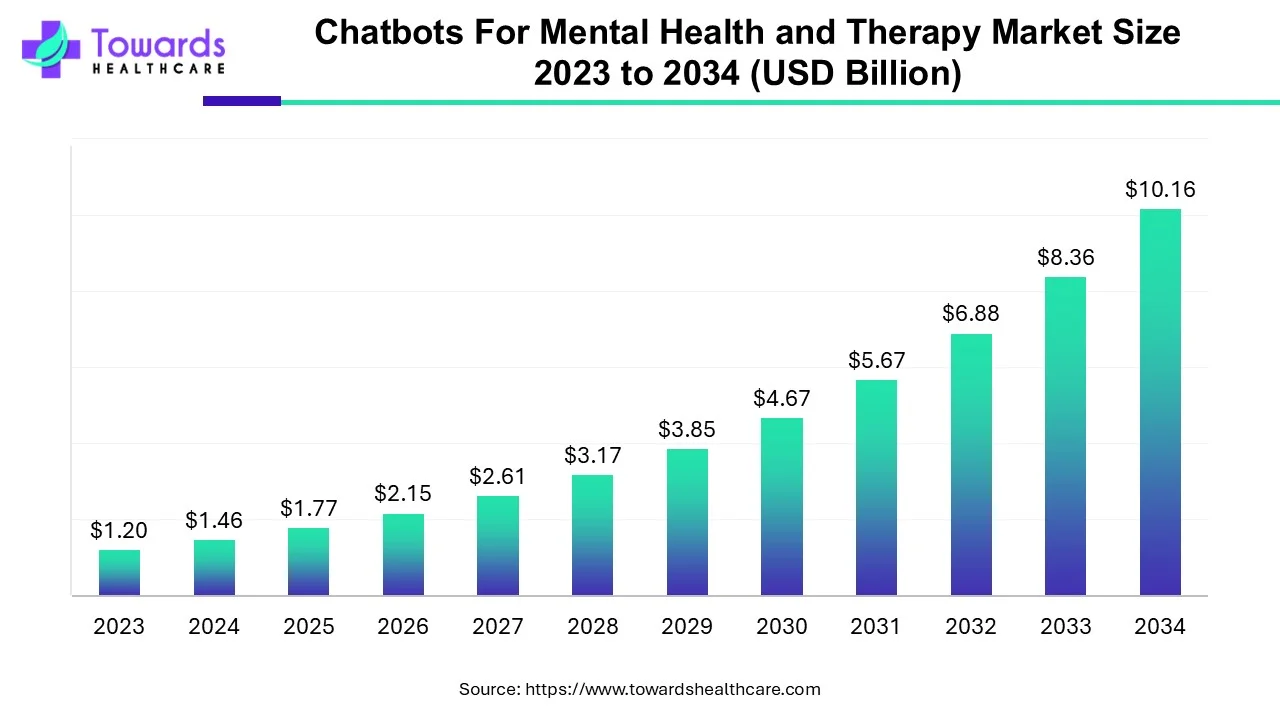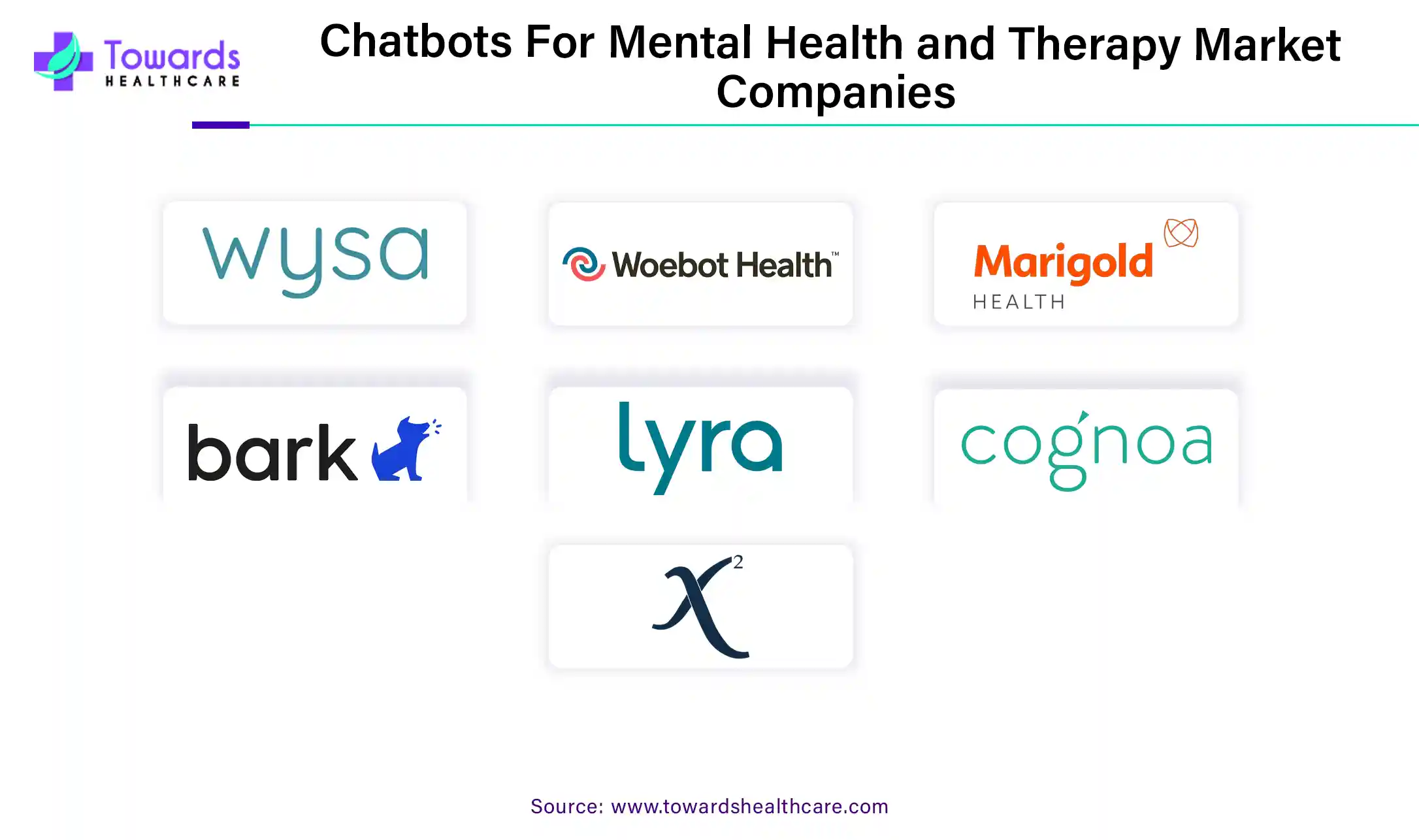December 2025

The chatbots for mental health and therapy market size is forecasted to expand from USD 1.77 billion in 2025 to USD 10.16 billion by 2034, growing at a CAGR of 21.3% from 2025 to 2034, as a result of rising demand for accessible and convenient healthcare services.

The market for chatbots in mental health and therapy is experiencing significant growth as the demand for accessible and convenient mental healthcare solutions continues to rise. Chatbots, powered by artificial intelligence (AI), are computer programs designed to simulate human conversation and provide support, guidance, and therapeutic interventions for individuals facing mental health challenges.
The market is driven by several factors, including the increasing prevalence of mental health disorders, limited access to mental healthcare professionals, and the growing acceptance and adoption of digital health technologies. Mental health conditions such as depression, anxiety, and stress-related disorders affect millions of people worldwide, creating a need for scalable and cost-effective solutions.
Chatbots offer several advantages in the field of mental health and therapy. They provide 24/7 availability, allowing individuals to seek support and guidance at any time. Chatbots can engage in personalized conversations, deliver evidence-based interventions, and provide psychoeducation to users. They can also monitor symptoms, track progress, and offer resources for self-help and self-care.
The increasing demand for accessible and convenient mental healthcare services is a major driver in the chatbots for the mental health and therapy market. Traditional mental healthcare services often face barriers that hinder individuals from accessing timely support when they need it most. Chatbots address these barriers by providing immediate access to mental health support. They can be accessed through various digital platforms, including smartphones and web-based applications, allowing users to engage in conversations from the comfort and privacy of their own homes. This convenience and accessibility make chatbots attractive for individuals seeking mental health support.
Due to the rise in the demand for mental health services, there is increased investment in the development of advanced chatbots for mental health and therapy. Furthermore, the increasing prevalence of mental health disorders significantly increases the adoption of chatbots for mental health and therapy. The COVID-19 pandemic also accelerated the case of mental health issues across the globe. According to a Lancet publication, the pandemic triggered 76 million cases of anxiety and 53 million cases of depression worldwide.

Moreover, the use of chatbots can help overcome the stigma associated with mental health. Some individuals may feel uncomfortable or hesitant to seek help from traditional mental healthcare providers due to perceived judgment or discrimination. Chatbots offer a non-judgmental and confidential space for individuals to express their concerns and receive support without fear of stigma.
Another major driver in the chatbots for the mental health and therapy market is the advancements in natural language processing (NLP) and machine learning algorithms. NLP allows chatbots to understand and interpret human language, enabling them to engage in meaningful conversations and provide appropriate responses. Machine learning algorithms enable chatbots to continuously learn and improve their responses based on user interactions and feedback. As more individuals engage with chatbots and provide input, the algorithms can adapt and refine their capabilities, making the interactions more personalized and effective.
These advancements in NLP and machine learning have led to the development of more sophisticated and intelligent chatbots for mental health and therapy. Chatbots can now detect and analyze sentiment, identify key concerns, and provide tailored interventions based on the user's specific needs. This personalized approach enhances the user experience and increases the effectiveness of the interventions.
In addition, the rise in product launches by major market participants augments the growth of the mental health and therapy market.
Thus, advances in and innovations in chatbot services intended for mental health and therapy, add to the growth of this market.
Furthermore, advancements in NLP and ML algorithms offer significant potential in improving the capabilities of chatbots for mental health and therapy. By enabling a better understanding of human language and personalizing the therapeutic experience, these advancements can enhance the accessibility and effectiveness of mental health support. However, ongoing research, ethical considerations, and continuous improvements are necessary to harness the full potential of these technologies in the context of mental health care.
One of the major restraints in the chatbots for the mental health and therapy market is the limitations of technology in fully understanding complex human emotions and experiences. While chatbots have advanced in their conversational abilities and natural language processing, they still face challenges in comprehending the intricate nuances of mental health issues. Mental health disorders often involve multifaceted symptoms, underlying causes, and individual variations. Human therapists bring a level of empathy, intuition, and clinical judgment that may be challenging for chatbots to replicate. Chatbots may struggle to recognize subtle cues, accurately interpret ambiguous statements, and provide appropriate interventions for complex mental health conditions.
Additionally, chatbots may face challenges in maintaining user engagement and trust. Establishing a strong therapeutic alliance is a crucial aspect of mental healthcare, and it relies on factors such as empathy, rapport, and the ability to provide emotional support. While chatbots can simulate empathy and provide information, they may not fully meet the emotional needs of individuals seeking human connection and support. Chatbots rely on algorithms and predefined responses to interact with users, which can sometimes lead to inaccurate or inadequate responses to complex emotional situations. The lack of real-time emotional understanding and empathy can hinder the effectiveness of chatbots, especially in cases where individuals require personalized and sensitive mental health interventions.
Furthermore, chatbots may face challenges in understanding and addressing the unique experiences and needs of individuals with complex mental health conditions. Conditions such as trauma, personality disorders, or severe depression often require specialized therapeutic approaches and human expertise to provide appropriate support. Chatbots, with their limited understanding of these complexities, may not be able to offer the same level of personalized and tailored interventions as human therapists. Moreover, the reliance on text-based communication can pose limitations in accurately assessing a person's mental state. Non-verbal cues, such as tone of voice or body language, play a significant role in understanding emotional states and providing appropriate support. Chatbots lack the ability to interpret these non-verbal.
By application, the conversational interfaces segment held the largest share of the market in 2024 and is projected to expand significantly in the market in the coming years. Conversational interfaces improve communication between therapists and patients through text-based chatbots, voice-activated assistants, or both. They play a key role in numerous aspects, from alleviating anxiety symptoms to providing a judgment-free space for self-expression. The ability to provide accessible, on-demand support and more human-like interaction experience potentiates the demand for conversational interfaces. The growing demand for tailored therapy favors the development of conversational interfaces.
By component, the SaaS segment led the global market in 2024 and will gain a significant share of the market over the studied period. Several companies offer apps, websites, and practice management tools as part of their Software-as-a-Service (SaaS) platform. Such software solutions enable healthcare professionals to manage therapy sessions, client records, and treatment plans. SaaS solutions also help therapists track patient progress, enhance patient engagement, and schedule appointments. They also increase efficiency, improve patient access, and enable scalability. The need to reduce administrative tasks and the demand for strengthening market position increases their adoption.
In regional insights, North America currently holds the largest market share in the chatbots for mental health and therapy market. The region is characterized by a high prevalence of mental health disorders, a strong focus on digital health solutions, and the presence of key market players. The United States, in particular, exhibits a major market share, driven by a combination of factors including a large population, high smartphone penetration, and a growing awareness of mental health. The region has a well-developed healthcare infrastructure and a high prevalence of mental health conditions, leading to a greater demand for accessible and scalable mental health solutions. In addition to the United States, Canada is also a key market in North America. The Canadian healthcare system emphasizes the importance of accessible mental health services, and chatbots are seen as a promising solution to bridge the gap between demand and available resources.
Market players in North America are positioning themselves to capitalize on the growing demand for chatbots in mental health and therapy. They are focusing on developing advanced natural language processing algorithms, incorporating machine learning and AI techniques to improve the accuracy and effectiveness of chatbot interactions. These players are also actively collaborating with mental health professionals and institutions to ensure that their chatbot solutions align with clinical guidelines and best practices.
However, the Asia Pacific region is projected to grow at the fastest rate in the upcoming years. The region is witnessing rapid urbanization, changing lifestyles, and increasing awareness of mental health. Countries such as China, India, and Japan are expected to contribute significantly to the market growth. The growing adoption of digital technologies and the rising demand for accessible mental healthcare solutions are driving the market expansion in this region.
Integrating chatbot technology with other digital health platforms and services presents a significant opportunity in the mental health and therapy market. By collaborating with telehealth providers, mobile applications, and electronic health record systems, chatbots can enhance the continuum of care and provide seamless transitions between different modes of support. Integration with telehealth platforms can enable chatbots to triage and direct individuals to appropriate levels of care, such as connecting them with mental healthcare professionals for in-depth assessments or scheduling appointments. Chatbots can also serve as a complement to therapy sessions, providing ongoing support and monitoring between sessions.
Furthermore, integration with mobile applications and wearable devices can enable chatbots to gather real-time data on user behavior, activity levels, and physiological indicators. This data can be analyzed to provide personalized insights, track progress, and offer tailored interventions. By leveraging the power of data and analytics, chatbots can contribute to more effective and personalized mental healthcare.
The market for chatbots in mental health and therapy is poised for significant growth as the demand for accessible and convenient mental healthcare solutions continues to rise. With advancements in technology and a focus on personalized interventions, chatbots have the potential to revolutionize mental health care delivery and provide support to individuals in need.

Dr. Alison Darcy, Founder of Woebot Health, commented that the future of mental health support is conversing with humans through screens and headsets. She also said that AI is transforming the accessibility and experience of therapeutic interventions through chatbots and virtual reality.

By Technology
By Application
By Component
By Geography
December 2025
December 2025
December 2025
December 2025